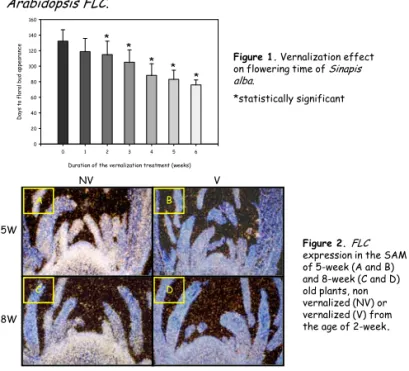Maria D’ALOIA
1, Dietmar STAHL
2, Claire PERILLEUX
1and Siegbert MELZER
11Laboratory of Plant Physiology, University of Liège, B22, Sart tilman, 4000 Liège, Belgium 2PLANTA GmbH, Grimsehlstrasse 31, 37555 Einbeck, Germany
In many plant species, flowering is promoted by a long exposure to low temperature, a process known as ‘vernalization’. Some plants even have an absolute requirement for winter cold before being able to flower the next summer, hence behave as biennials or winter crops. A recent breakthrough in the understanding of the molecular bases of vernalization has been the cloning of theFLOWERING LOCUS C (FLC) gene inArabidopsis thaliana(1).FLCencodes a repressor of flowering and is downregulated by vernalization. So vernalization relieves the inhibitory role that FLC plays on downstream genes involved in the floral transition of the shoot apical meristem (SAM).
In the present work, we have investigated the key role ofFLCby two different strategies.
Although vernalization has been shown, by physiological studies, to be sensed by the SAM, molecular evidence is missing. Such analyses are impaired in Arabidopsis by the small size of the plant and the rosette growth habit. We therefore used a caulescent relativeBrassicaceae: mustard (Sinapis albaL.).
1) Characterization of vernalization effect on flowering time in
Sinapis. Plants were grown in 8-h short days, 20°C for two
weeks, then were exposed to cold (7°C) for 1, 2, 3, 4, 5 or 6 weeks before being returned to 20°C. Flowering time was recorded as ‘days to floral bud appearance’ (Figure 1).
2) Isolation of FLC homologues. A cDNA library made from
Sinapis leaf mRNA (2) was screened with a PCR probe from
Arabidopsis FLC.
Duration of the vernalization treatment (weeks)
0 1 2 3 4 5 6 D ay s to flor al b ud ap pea ran ce 0 20 40 60 80 100 120 140 160
Figure 1. Vernalization effect on flowering time of Sinapis alba.
*statistically significant
Figure 2. FLC expression in the SAM of 5-week (A and B) and 8-week (C and D) old plants, non vernalized (NV) or vernalized (V) from the age of 2-week. 5W
8W
NV V
Results
1) Figure 1 shows that a two-week duration of vernalization is sufficient to accelerate flowering. The longer the vernalization period, the shorter the time to floral bud appearance.
2) We isolated two FLChomologues. One of them, SaFLC1, was used for in situ hybridizations on SAM sections and it was observed thatFLCtranscript level decreased with vernalization (Figure 2).
Because of its agronomical importance, we have also tried to manipulate the vernalization process in crops. By using a transgenic approach, we have attempted to bypass the strict vernalization requirement of winter colza (Brassica napusL.), the third most important source of vegetable oil in the world (3).
We have over-expressed a gene which acts as a positive regulator of flowering and is repressed byFLCin non-vernalized wild type plants. This gene, cloned from Sinapis, is called
SaMADS A(2).
Table 1. Effect of SaMADS A over-expression on flowering time of winter colza. Unvernalized plants were grown in 16-h long days, 20°C.
Results
We observed that transgenic lines did flower without vernalization while the WT did not (table 1 and figure 3). Thus the strict vernalization requirement of winter colza can be bypassed by constitutive expression ofSaMADS A.
102,8 ± 24,1 Line 4 105,2 ± 10,5 Line 3 114,5 ± 18,3 Line 2 SaMADS A over-expressor 122,5 ± 36,3 Line 1 ∞ WT Days to floral bud appearance References
(1) Michaels S.D. and Amasino R.M. (1999) FLOWERING LOCUS C encodes a novel MADS domain protein that acts as a repressor of flowering. The Plant Cell 11, 949-956. (2) Menzel G., Apel K. and Melzer S. (1996) Identification of two MADS box genes that are expressed in the apical meristem of the long-day plant Sinapis alba in transition to flowering. The Plant Journal 9, 399-408.
(3) Sovero M. (1993) Rapeseed, a new oilseed crop for the United States. In New crops (eds J. Janick and J.E. Simon), Wiley, New York, pp 302-307.
Acknowledgements
Maria D’ALOIA is grateful to the F.R.I.A. for the award of a research fellowship. Figure 3. Phenotype of wild type (A) and of a transgenic line over-expressing SaMADS A (B).
FLC
flowering
vernalization
The promotion of flowering in response to cold:
from molecular bases to manipulation in
Brassicaceae
A B C D * * * * * A B
